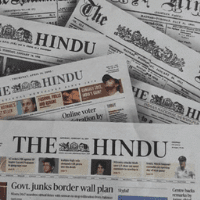Current Affairs Exam > Current Affairs Questions > Consider the following statements:1. The Subs...
Start Learning for Free
Consider the following statements:
1. The Subsidiary Alliance was introduced by Robert Clive in 1798.
2. The first Subsidiary Treaty was signed with the Nawab of Avadh.
3. The British controlled the defence and foreign relations of the protected ally under Subsidiary Treaty.
Which of the statements given above is/are correct?
- a)1 and 2 only
- b)2 only
- c)3 only
- d)1, 2 and 3
Correct answer is option 'C'. Can you explain this answer?
Verified Answer
Consider the following statements:1. The Subsidiary Alliance was intro...
- In 1798, Subsidiary Alliance was introduced by Lord Wellesley in India, the ruler of the allying Indian state was compelled to pay a subsidy for the maintenance of British army in return for getting protection from the British against their enemies. Hence, statement 1 is not correct.
- Those native princes or rulers who would enter into the Subsidiary Alliance were not free to declare war against any other power or enter into negotiations without the consent of the British.
- The Subsidiary Alliance was a policy of non-interference in the internal affairs of the allied state, but this was a promise seldom kept by the British.
- The payment of the arbitrarily-fixed and artificially-bloated subsidy invariably disrupted the economy of the state and impoverished its people.
- On the other hand, the British could now maintain a large army at the cost of the Indian states.
- They controlled the defence and foreign relations of the protected ally, and had a powerful force stationed at the very heart of his lands. Hence, statement 3 is correct.
- Lord Wellesley signed his first Subsidiary Treaty with the Nizam of Hyderabad in 1798.
- The Nawab of Avadh was forced to sign a Subsidiary Treaty in 1801. Hence, statement 2 is not correct.
- Peshwa Baji Rao II (Maratha) signed the Subsidiary Treaty at Bassein in 1802.
Most Upvoted Answer
Consider the following statements:1. The Subsidiary Alliance was intro...
Subsidiary alliance introduced by lord Wellesley in year 1798.
The Nizam of Hyderabad was the first to accept a well-framed subsidiary alliance in 1798.
so c is correct option
The Nizam of Hyderabad was the first to accept a well-framed subsidiary alliance in 1798.
so c is correct option
Free Test
FREE
| Start Free Test |
Community Answer
Consider the following statements:1. The Subsidiary Alliance was intro...
The correct answer is option 'C' - 3 only.
1. The Subsidiary Alliance was introduced by Robert Clive in 1798:
- This statement is incorrect. The Subsidiary Alliance was not introduced by Robert Clive in 1798. It was actually introduced by Lord Wellesley, the Governor-General of India, in the early 19th century.
2. The first Subsidiary Treaty was signed with the Nawab of Avadh:
- This statement is incorrect. The first Subsidiary Treaty was not signed with the Nawab of Avadh. It was signed with the Nizam of Hyderabad in 1798. The purpose of this treaty was to establish British control over the Nizam's military and foreign policy.
3. The British controlled the defense and foreign relations of the protected ally under Subsidiary Treaty:
- This statement is correct. The Subsidiary Treaty was a system established by the British East India Company to expand its control over the Indian princely states. Under this system, the British would provide military protection to the princely states in exchange for control over their defense and foreign relations. The British controlled the defense and foreign policy of the protected ally, allowing them to exert their influence and maintain control over the region.
Overall, only statement 3 is correct. The Subsidiary Alliance was introduced by Lord Wellesley, the first Subsidiary Treaty was signed with the Nizam of Hyderabad, and the British did control the defense and foreign relations of the protected allies under the Subsidiary Treaty system.
1. The Subsidiary Alliance was introduced by Robert Clive in 1798:
- This statement is incorrect. The Subsidiary Alliance was not introduced by Robert Clive in 1798. It was actually introduced by Lord Wellesley, the Governor-General of India, in the early 19th century.
2. The first Subsidiary Treaty was signed with the Nawab of Avadh:
- This statement is incorrect. The first Subsidiary Treaty was not signed with the Nawab of Avadh. It was signed with the Nizam of Hyderabad in 1798. The purpose of this treaty was to establish British control over the Nizam's military and foreign policy.
3. The British controlled the defense and foreign relations of the protected ally under Subsidiary Treaty:
- This statement is correct. The Subsidiary Treaty was a system established by the British East India Company to expand its control over the Indian princely states. Under this system, the British would provide military protection to the princely states in exchange for control over their defense and foreign relations. The British controlled the defense and foreign policy of the protected ally, allowing them to exert their influence and maintain control over the region.
Overall, only statement 3 is correct. The Subsidiary Alliance was introduced by Lord Wellesley, the first Subsidiary Treaty was signed with the Nizam of Hyderabad, and the British did control the defense and foreign relations of the protected allies under the Subsidiary Treaty system.

|
Explore Courses for Current Affairs exam
|

|
Similar Current Affairs Doubts
Consider the following statements:1. The Subsidiary Alliance was introduced by Robert Clive in 1798.2. The first Subsidiary Treaty was signed with the Nawab of Avadh.3. The British controlled the defence and foreign relations of the protected ally under Subsidiary Treaty.Which of the statements given above is/are correct?a)1 and 2 onlyb)2 onlyc)3 onlyd)1, 2 and 3Correct answer is option 'C'. Can you explain this answer?
Question Description
Consider the following statements:1. The Subsidiary Alliance was introduced by Robert Clive in 1798.2. The first Subsidiary Treaty was signed with the Nawab of Avadh.3. The British controlled the defence and foreign relations of the protected ally under Subsidiary Treaty.Which of the statements given above is/are correct?a)1 and 2 onlyb)2 onlyc)3 onlyd)1, 2 and 3Correct answer is option 'C'. Can you explain this answer? for Current Affairs 2025 is part of Current Affairs preparation. The Question and answers have been prepared according to the Current Affairs exam syllabus. Information about Consider the following statements:1. The Subsidiary Alliance was introduced by Robert Clive in 1798.2. The first Subsidiary Treaty was signed with the Nawab of Avadh.3. The British controlled the defence and foreign relations of the protected ally under Subsidiary Treaty.Which of the statements given above is/are correct?a)1 and 2 onlyb)2 onlyc)3 onlyd)1, 2 and 3Correct answer is option 'C'. Can you explain this answer? covers all topics & solutions for Current Affairs 2025 Exam. Find important definitions, questions, meanings, examples, exercises and tests below for Consider the following statements:1. The Subsidiary Alliance was introduced by Robert Clive in 1798.2. The first Subsidiary Treaty was signed with the Nawab of Avadh.3. The British controlled the defence and foreign relations of the protected ally under Subsidiary Treaty.Which of the statements given above is/are correct?a)1 and 2 onlyb)2 onlyc)3 onlyd)1, 2 and 3Correct answer is option 'C'. Can you explain this answer?.
Consider the following statements:1. The Subsidiary Alliance was introduced by Robert Clive in 1798.2. The first Subsidiary Treaty was signed with the Nawab of Avadh.3. The British controlled the defence and foreign relations of the protected ally under Subsidiary Treaty.Which of the statements given above is/are correct?a)1 and 2 onlyb)2 onlyc)3 onlyd)1, 2 and 3Correct answer is option 'C'. Can you explain this answer? for Current Affairs 2025 is part of Current Affairs preparation. The Question and answers have been prepared according to the Current Affairs exam syllabus. Information about Consider the following statements:1. The Subsidiary Alliance was introduced by Robert Clive in 1798.2. The first Subsidiary Treaty was signed with the Nawab of Avadh.3. The British controlled the defence and foreign relations of the protected ally under Subsidiary Treaty.Which of the statements given above is/are correct?a)1 and 2 onlyb)2 onlyc)3 onlyd)1, 2 and 3Correct answer is option 'C'. Can you explain this answer? covers all topics & solutions for Current Affairs 2025 Exam. Find important definitions, questions, meanings, examples, exercises and tests below for Consider the following statements:1. The Subsidiary Alliance was introduced by Robert Clive in 1798.2. The first Subsidiary Treaty was signed with the Nawab of Avadh.3. The British controlled the defence and foreign relations of the protected ally under Subsidiary Treaty.Which of the statements given above is/are correct?a)1 and 2 onlyb)2 onlyc)3 onlyd)1, 2 and 3Correct answer is option 'C'. Can you explain this answer?.
Solutions for Consider the following statements:1. The Subsidiary Alliance was introduced by Robert Clive in 1798.2. The first Subsidiary Treaty was signed with the Nawab of Avadh.3. The British controlled the defence and foreign relations of the protected ally under Subsidiary Treaty.Which of the statements given above is/are correct?a)1 and 2 onlyb)2 onlyc)3 onlyd)1, 2 and 3Correct answer is option 'C'. Can you explain this answer? in English & in Hindi are available as part of our courses for Current Affairs.
Download more important topics, notes, lectures and mock test series for Current Affairs Exam by signing up for free.
Here you can find the meaning of Consider the following statements:1. The Subsidiary Alliance was introduced by Robert Clive in 1798.2. The first Subsidiary Treaty was signed with the Nawab of Avadh.3. The British controlled the defence and foreign relations of the protected ally under Subsidiary Treaty.Which of the statements given above is/are correct?a)1 and 2 onlyb)2 onlyc)3 onlyd)1, 2 and 3Correct answer is option 'C'. Can you explain this answer? defined & explained in the simplest way possible. Besides giving the explanation of
Consider the following statements:1. The Subsidiary Alliance was introduced by Robert Clive in 1798.2. The first Subsidiary Treaty was signed with the Nawab of Avadh.3. The British controlled the defence and foreign relations of the protected ally under Subsidiary Treaty.Which of the statements given above is/are correct?a)1 and 2 onlyb)2 onlyc)3 onlyd)1, 2 and 3Correct answer is option 'C'. Can you explain this answer?, a detailed solution for Consider the following statements:1. The Subsidiary Alliance was introduced by Robert Clive in 1798.2. The first Subsidiary Treaty was signed with the Nawab of Avadh.3. The British controlled the defence and foreign relations of the protected ally under Subsidiary Treaty.Which of the statements given above is/are correct?a)1 and 2 onlyb)2 onlyc)3 onlyd)1, 2 and 3Correct answer is option 'C'. Can you explain this answer? has been provided alongside types of Consider the following statements:1. The Subsidiary Alliance was introduced by Robert Clive in 1798.2. The first Subsidiary Treaty was signed with the Nawab of Avadh.3. The British controlled the defence and foreign relations of the protected ally under Subsidiary Treaty.Which of the statements given above is/are correct?a)1 and 2 onlyb)2 onlyc)3 onlyd)1, 2 and 3Correct answer is option 'C'. Can you explain this answer? theory, EduRev gives you an
ample number of questions to practice Consider the following statements:1. The Subsidiary Alliance was introduced by Robert Clive in 1798.2. The first Subsidiary Treaty was signed with the Nawab of Avadh.3. The British controlled the defence and foreign relations of the protected ally under Subsidiary Treaty.Which of the statements given above is/are correct?a)1 and 2 onlyb)2 onlyc)3 onlyd)1, 2 and 3Correct answer is option 'C'. Can you explain this answer? tests, examples and also practice Current Affairs tests.

|
Explore Courses for Current Affairs exam
|

|
Signup for Free!
Signup to see your scores go up within 7 days! Learn & Practice with 1000+ FREE Notes, Videos & Tests.





















